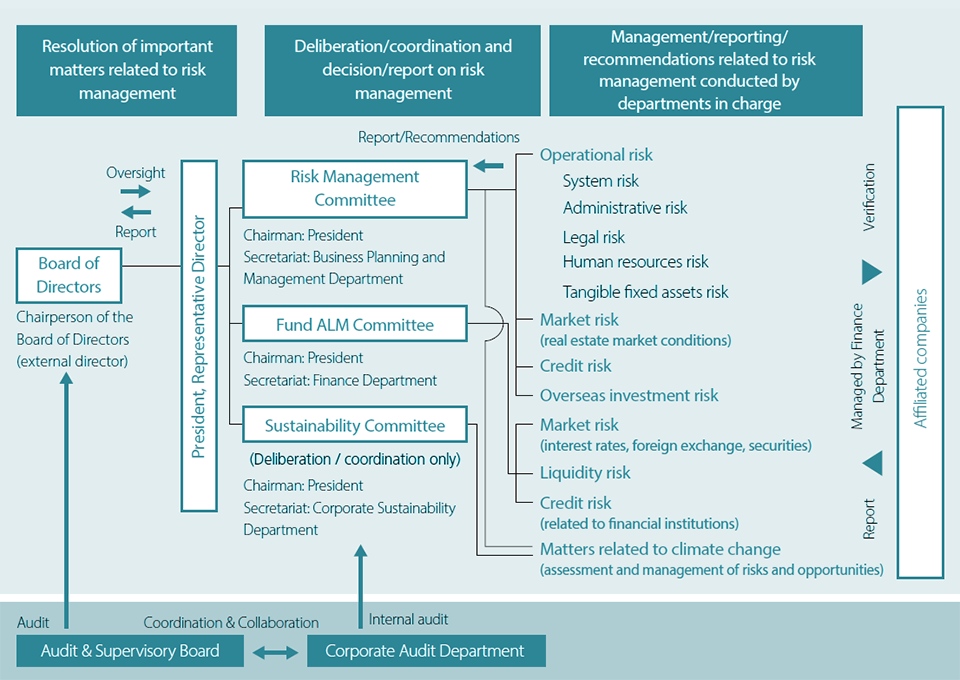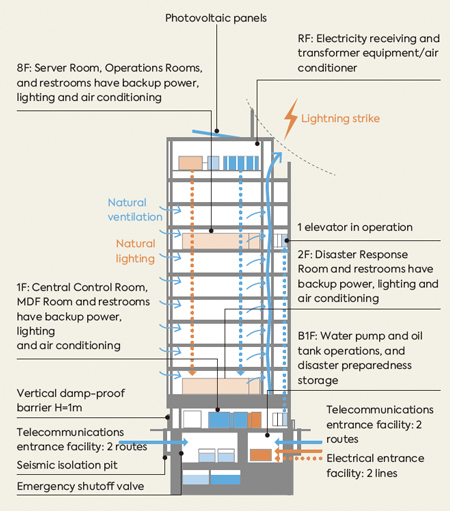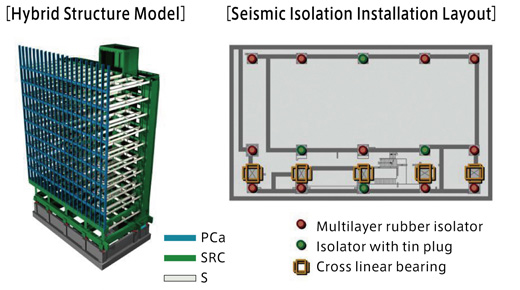Fundamental Approach
Pursuant to the Basic Rules of Risk Management, we manage various risks related to the Hulic Group's businesses, which include operational, market, liquidity, and credit risk, among others.
Results in FY2024
- Number of Risk Management Committee meetings: 4 times
- Number of Fund ALM Committee meetings: 16 meetings (12 regular meetings, 4 special meetings)
- Number of BCP drills: 3 times
- Number of inspections of stockpiled food: 4 times
- Number of inspections of stockpiled goods: 4 times
Risk Management Structure
Hulic recognizes that appropriately managing risks of the Company and its affiliates is one of its most important management challenges, and has set up a structure with the Board of Directors at the top while working to make improvements. The department responsible for a particular risk stripe formulates risk management method, then appropriately monitor and control risk. The status of risk management is reported to the Risk Management Committee and Fund ALM Committee regularly and as required by the department in charge with its recommendations. The Board of Directors resolves important matters related to risk management upon receiving reports from the Committees.
Corporate audit department implements internal audit and confirms the appropriateness of risk management and reports the result to the Board of Directors. Then, the Board of Directors conduct review accordingly. In addition, risk items are reviewed and added as required.
In 2024, the Fund ALM Committee held 4 special meetings in addition to regular monthly meetings in order to closely monitor interest rates, securities and other market risks, in an effort to flexibly respond to each risk scenario.
Risk Management Structure Chart
As of December 31, 2024

Business Continuity Initiatives for Disasters
Business Continuity Approach for Disasters
Hulic is a real estate company that engages in development, reconstruction, and operation of office buildings etc. primarily in Tokyo 23 wards. We are constantly working to generate new added value by offering properties that are superior in terms of safety, environmental performance, and convenience. We have established various emergency and disaster scenarios for which we have created measures to improve the structural performance of our buildings as well as operational and management aspects.
Establishment of the Basic Plan for Business Continuity
Our Basic Plan for Business Continuity defines the framework and method for continuing important business functions while minimizing damage to business assets in the event of an emergency, such as a metropolitan epicentral earthquake. We have also created the BCP Manual outlining specific execution plans and have thoroughly communicated the contents of the manual to officers and employees.
In addition, a disaster response training drill is held at least once a year. These drills test setting up an emergency response headquarters, verify the operation of the safety confirmation system, and provide training on communication and information gathering, among other things. The drills reaffirm the importance of business continuity for executives and employees as well as the standards of behavior related to disaster countermeasures. Further, we analyze and evaluate the issues identified in the drills and work to build a more practical BCP (business continuity plan) system by reflecting these issues in a revised BCP manual.
As a real estate company that develops and owns numerous properties, Hulic needs to prepare for possible disasters. In addition to measures for “hardware” (structural), such as a building's structure, we are taking various steps on the “software,” (operational and managerial) as well, which are reviewed when necessary.
Review and Improvement of the Basic Plan for Business Continuity


Hulic reconfirms basic responses against disaster through annual BCP drill based on the Basic Plan for Business Continuity. The drill tests processes of establishing an emergency response headquarters, verifies operation of the safety confirmation system, and provides training on communication and information gathering among other things. This serves to reaffirm the importance of business continuity for executives and employees as well as standards of behavior related to disaster countermeasures. Furthermore, we analyze and evaluate the issues identified in the drill, and work to build a more practical BCP system by reflecting these issues in a revised BCP manual.
We also established a cross-sectional cooperation with external organizations including design companies, construction companies, management companies as well as elevator companies to ensure continuity of real estate business.
In 2025, instructors from the Japan Red Cross Society specializing in disaster prevention visited the Company and held a disaster preparedness seminar, which focused on ways to reduce the impact of disasters inside and outside the home. The seminar taught practical skills such as how to stop bleeding and immobilize an injury, among other first aid techniques.
Facilities and Stockpiles for Sustaining Business Operations
We are proactively carrying out measures to strengthen the business continuity capabilities of our head office functions during an emergency. The following measures have been taken at the Hulic Head Office Building.
- Adopts earthquake-absorbing structures that enable building functions to operate even during an earthquake with a seismic intensity of 7 level
- Features emergency generators that can operate continuously for up to six days
- Secures food and drinking water to last more than seven days

Maintaining Functions during a Disaster (Hulic Head Office Building)

Diagram of Hybrid Structure Model

Earthquake Resistance Performance of Buildings
As an earthquake-resistant initiative, Hulic is working on development, reconstruction, new acquisition and seismic reinforcement of buildings which aim to build a leasing portfolio of 100% highly earthquake-resistant buildings. Our earthquake resistance standards, stricter than those in the Building Standards Act, are adopted for all the buildings we develop and reconstruct, including offices, commercial facilities, hotels, Japanese-style inns, residential homes, and others. Our standards ensure building performance that can safeguard human life and enable continued use of the building with post-earthquake repair in the event of an earthquake with a seismic intensity of 7 level. In addition, we ensure that its new office buildings meet the highest earthquake resistance standards by equipping them with the most suitable structure type we adopted for the various conditions of the development building from earthquake-absorbing, earthquake-damping and earthquake-resistant structures. Additionally, we also stockpile water, set up a drainage system, and install emergency back-up generators that can generate power continuously for three days in our buildings. On the other hand, we also conduct the necessary seismic reinforcement and screening to maintain the earthquake resistance of its buildings other than we develop and reconstruct to a level that can withstand earthquakes of seismic intensity 7 level.
Link: Framework for Collaboration and Cooperation with Related Parties and BusinessPartners
